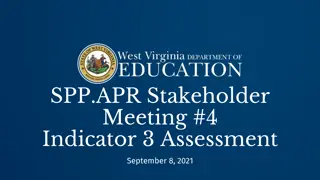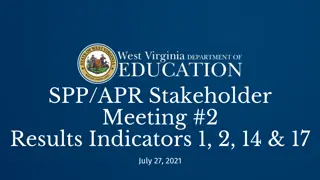Partnership Internal Communications Plan & Stakeholder Analysis
Developing an effective internal communications plan for a partnership involves drawing insights from stakeholder analysis, drafting, validating, and implementing the plan. Engaging with internal stakeholders, understanding their awareness, engagement levels, and expectations, and prioritizing communication activities are crucial steps. The plan should include a mix of partnership status, routine, and engaging communications tailored to different audiences. Stakeholder prioritization helps in deciding the communication and engagement levels required. Continuous monitoring, feedback collection, and plan updates are essential for maintaining effective internal communications within the partnership.
Uploaded on Sep 26, 2024 | 1 Views
Download Presentation

Please find below an Image/Link to download the presentation.
The content on the website is provided AS IS for your information and personal use only. It may not be sold, licensed, or shared on other websites without obtaining consent from the author. Download presentation by click this link. If you encounter any issues during the download, it is possible that the publisher has removed the file from their server.
E N D
Presentation Transcript
Partnership internal communications plan Guidance and template
Internal communications -process Draw insights from stakeholder analysis Draft plan Validate plan Implement plan Evaluate and update Identify all internal stakeholders Evaluate their current level of awareness and engagement in the partnership objectives Analyse their expectations regarding the partnership and its ways of working Analyse their possible concerns regarding the partnership and its ways of working Based on the partnership objectives and stakeholder analysis, Define the purpose of communications Pick a relevant mix of different communications activities from each category (partnership status and direction, routine and engaging communications) Fill in the internal communications plan (audience, channel, responsible person and timing) Arrange a meeting with the core partners Present your drafted plan and request for comments Decide on the responsibilities and schedule for the next 6 months Finalize the plan Store internal communications plan and schedule in a place where everybody can access it. Share the plan with all the relevant people! Include communications tasks in your own work plans Build channels and materials Send calendar invitations, select meeting/celebration venues Decide on the meeting agendas, meeting minute structure, visual looks (e.g. partnership banner in e- Newsletter) Decide on feedback channels (see partner satisfaction and engagement) Start implementing! Follow up internal communications plan implementation Collect feedback from partners and analyse level of engagement Update plan accordingly
Drawing insights from stakeholder analysis Stakeholder prioritization helps to decide on the level of communications and engagement activities needed Public sector 1. Key stakeholders engage and collaborate Regular two-way interaction Direct targeted communications Joint learning and decision-making Personal relationships Usually core partners 2. Primary stakeholders* influence and motivate Direct targeted communications Occasional personal interaction Issues and objectives at stake Usually partnership target groups Private sector Civil society Key stakeholders 3. Secondary stakeholders - keep informed and interested Close working relationship Provide information Show consideration and support Usually non-core partners or other actors Primary stakeholders Secondary stakeholders *Nb. Partnership target groups are not internal stakeholders. Communications and engagement activities should be added to partnership implementation plan.
Elements of the partnership internal communications Depending on the partnership objectives and stakeholder analysis, different kind of communications activities should be planned Engaging communications Field trip Celebrations Workshops Ensuring engagement Continuous communications Regular meetings/skype calls Partnership website Social media Success stories Building Momentum Partnership status and direction Regular meetings/skype calls Partnership status Meeting minutes Establishing Routines
Internal communications activity planning some examples Type Channel Description Target audience Timing Partnership overview and recent highlights Status update, risks and interdependencies Required decisions and next steps Partnership status and direction Steering group meeting Steering group members Monthly Meeting minutes Email As agreed with partners Monthly E.g. steering group greetings, upcoming activities, recent success stories, links to partnership website and social media, introduction of new partners Routine communications e-Newsletter All partners Monthly/Bi-monthly Day-to-day implementation decisions, advice or support Meeting/Skype meeting Core partners Ad hoc Unofficial meeting with focus on relationship building Engaging communications Lunch meeting Partners Ad hoc Informal celebration (dinner or similar) MOU signing celebration Core partners In the end of Commit- phase Member participate in a deep dive into the partnership that contains strategic planning May incorporate interactive team sessions and networking opportunities Strategy workshop Core partners Annually Closing ceremony All partners In the end of Act -phase Organized visit to the field Field trip All partners In the beginning of partnership Facilitated workshop Lessons learnt workshop Core partners In the scale & exit - phase
Partnership internal communications - template Make sure your internal communications plan is realistic and shared with all relevant actors Reason for communications Communications activity Channel Audience Timing Responsible Comments Every 1stFriday of a month Regular status overview and agreement on upcoming tasks Steering group meeting Meeting Steering group N.N. Standard agenda E.g. Make sure agreed tasks are completed and followed up Meeting minutes Email Core partners Next Monday after the steering group meeting N.N. Standard structure January 15th, March 15th, May 15th Sharing recent success stories and increasing awareness of the issues e-Newsletter Email All partners, identified potential partners N.N. Content decided in steering group meeting Increasing engagement and celebrating success Christmas lunch Local restaurant All partners 15.12. N.N. Unofficial, no agenda























